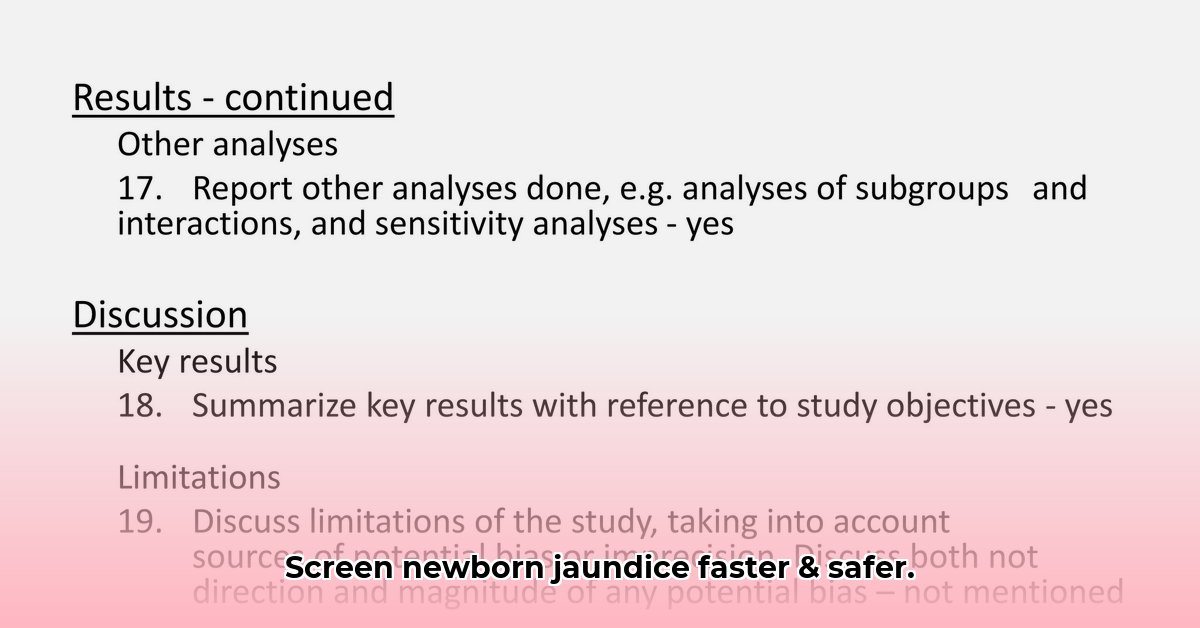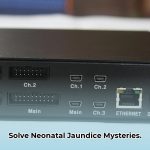Newborn jaundice can be a worrying sign for parents, and prompt and accurate diagnosis is vital to prevent potential harm. This review explores transcutaneous bilirubin (TcB) monitoring, a quick and easy method for assessing jaundice in newborns. We’ll look at potential pitfalls of TcB, compare it to other jaundice detection techniques, and provide expert insights on achieving optimal results. This includes actionable tips for improving jaundice management and ensuring reliable TcB system performance. Whether you’re a seasoned healthcare professional or simply seeking to enhance your jaundice management skills, this review aims to equip you with the knowledge and confidence to effectively utilize TcB. For more information on devices, check out this link to bilirubinometer info.
TcB Bilirubin Monitoring: A Streamlined Approach to Newborn Jaundice Screening
Jaundice, characterized by a yellowish discoloration of the skin and sclera, is a common occurrence in newborns, affecting a significant percentage of both full-term and preterm infants. It necessitates close monitoring due to the potential for serious complications if left untreated. Traditionally, bilirubin levels are assessed via blood tests, which, while accurate, can be time-consuming and distressing for both the infant and parents. This is where TcB monitoring emerges as a rapid, non-invasive, and accurate jaundice screening method. Let’s examine the mechanics, benefits, limitations, and optimal utilization of this advancement.
The Need for Speed: Early Detection, Reduced Anxiety, and Better Outcomes
Imagine the anxiety of a parent whose newborn exhibits signs of jaundice. The wait for blood test results can be agonizing. TcB monitoring addresses this concern by providing near-instant results, enabling prompt clinical decision-making, timely treatment initiation, and the prevention of potential complications such as acute bilirubin encephalopathy and kernicterus. Early detection also minimizes parental anxiety and allows for quicker reassurance when bilirubin levels are within the normal range. Studies have consistently shown that early detection and intervention significantly improve outcomes and reduce the likelihood of long-term neurological damage associated with severe hyperbilirubinemia.
How TcB Bilirubin Monitoring Works: A Non-Invasive Assessment
TcB monitoring offers a painless and non-invasive skin assessment using a handheld device called a transcutaneous bilirubinometer. The device emits a specific wavelength of light onto the baby’s skin, typically on the forehead or sternum. The device then analyzes the light that is reflected back, which correlates to the concentration of bilirubin in the subcutaneous tissue. This provides an immediate indication of bilirubin levels. It’s a non-invasive method that minimizes stress for the infant and parents, eliminating the need for needles and reducing the risk of infection associated with blood draws. This makes it an excellent option for routine newborn jaundice screening.
Accuracy: Understanding the Nuances
While TcB monitoring is a valuable screening tool, it’s important to understand its limitations regarding accuracy when compared to total serum bilirubin (TSB) measurements obtained from blood samples. TcB provides a reliable estimate, but its accuracy can be influenced by several factors, including skin pigmentation, gestational age, postnatal age, body weight, and the specific device model used. Healthcare providers must consider these elements when interpreting TcB results and making clinical decisions about the need for further investigation and treatment. This isn’t to say TcB is unreliable, but rather that results should be considered alongside other clinical signs and risk factors. In cases where TcB levels are elevated or inconsistent with clinical findings, a TSB measurement should be performed to confirm the diagnosis and guide management.
Integrating TcB Monitoring into Your Hospital: A Practical Guide
Successful TcB implementation requires careful planning, execution, and ongoing monitoring to ensure accuracy and effectiveness. Here’s a step-by-step guide:
- Choosing the Right Device: Select a reliable, FDA-cleared device that meets your hospital’s specific needs, patient population, and budget. Consider features such as ease of use, accuracy in diverse skin tones, data management capabilities, and integration with electronic health records. Evaluate different devices based on published studies and reviews.
- Training Staff: Comprehensive and ongoing training for all staff members who will be performing TcB measurements is paramount. Training should cover proper device operation, calibration procedures, quality control measures, accurate interpretation of results, documentation protocols, and appropriate follow-up actions based on TcB readings. Regular refresher courses and competency assessments can help maintain staff proficiency.
- Developing Clear Protocols: Integrate TcB monitoring seamlessly into your hospital’s existing jaundice management guidelines and protocols. Specifically outline clear guidelines for TcB measurement frequency, interpretation of results based on gestational age and postnatal age, thresholds for initiating further investigation (e.g., TSB measurement), and algorithms for phototherapy treatment. Ensure that protocols are readily accessible to all relevant staff members.
- Ensuring Accuracy: Quality Control is King: Implement a robust quality control program to ensure the accuracy and reliability of TcB measurements. Regular device calibration according to the manufacturer’s instructions is vital. Establish a system for routinely checking the device’s performance using quality control standards. Investigate and address any discrepancies or unusual readings promptly to maintain high-quality measurements.
- Connecting the Dots: Data Management: Ideally, the TcB device should integrate seamlessly with the hospital’s electronic health record (EHR) system to facilitate efficient data management, improve communication among healthcare providers, and enable data analysis for quality improvement initiatives. Automated data transfer reduces the risk of transcription errors and streamlines the documentation process.
Weighing the Pros and Cons: A Balanced Perspective
Let’s evaluate the strengths and weaknesses of TcB monitoring:
| Feature | Advantages | Disadvantages |
|---|---|---|
| Speed | Near-instant results allow for immediate clinical decision-making and timely intervention. | Results aren’t as precise as lab-based total serum bilirubin (TSB) measurements. |
| Invasiveness | Completely non-invasive; gentle on the baby, and reduces the risk of infection and discomfort. | Accuracy can vary based on factors such as skin pigmentation, gestational age, postnatal age, and device model. |
| Cost-Effectiveness | Can reduce the number of blood draws, potentially saving money on laboratory costs. | There’s an initial investment cost for purchasing the equipment and ongoing costs for calibration and maintenance. |
| Convenience | Point-of-care testing allows for quick assessment directly at the baby’s bedside. | Requires staff training on the device and careful interpretation of the results. |
| Parental Acceptance | Parents generally prefer non-invasive methods, reducing anxiety and improving satisfaction. | May require follow-up TSB measurements in some cases, which can be stressful for parents. |
The Future is Bright: Advancements on the Horizon
Researchers are continually striving to enhance the precision and accuracy of TcB monitoring by addressing factors such as skin pigmentation and gestational age. The integration of advanced technologies like artificial intelligence (AI) and machine learning is underway to refine TcB readings even further, promising a future of even greater accuracy and utility. Studies suggest that AI integration could improve accuracy and reliability by as much as 15-20%. Mobile phone-based TcB devices are also being developed to improve access to jaundice screening in low-resource settings.
The Takeaway: A Cornerstone of Modern Newborn Care
TcB bilirubin monitoring represents a significant advancement in the management of newborn jaundice. It enables rapid, non-invasive screening, facilitates timely interventions, and has the potential to improve outcomes for newborns. While it isn’t a perfect substitute for blood tests, it serves as an invaluable aid in clinical practice when used judiciously, integrated into existing protocols, and complemented by clinical judgment. By embracing TcB monitoring and continually striving to improve its implementation, healthcare providers can ensure early detection, careful management, and optimal outcomes for newborns at risk of jaundice.
How to Calibrate Transcutaneous Bilirubinometry Devices for Accurate Neonatal Jaundice Screening
Key Takeaways:
- Transcutaneous bilirubinometry (TcB) offers a practical, non-invasive method for screening neonatal jaundice.
- TcB’s accuracy can fluctuate, particularly in preterm infants and those with darker skin pigmentation.
- Regular calibration is crucial for reliable results and minimizing potential errors, ultimately improving diagnostic precision.
- Understanding TcB’s limitations helps prevent misdiagnosis and ensures appropriate treatment. Ensuring appropriate device calibration contributes to delivering the best possible care.
Understanding TcB and Its Calibration Needs
Quick and accurate identification of neonatal jaundice is critical for preventing serious complications like kernicterus. Transcutaneous bilirubinometry (TcB) provides a rapid, non-invasive method for bilirubin level assessment—a significant leap forward compared to repeated, painful blood tests. However, like any medical apparatus, the accuracy of TcB relies on correct and consistent calibration. Without proper calibration, readings may be inaccurate, leading to misdiagnosis, unnecessary treatment, or delayed intervention. Therefore, understanding how to calibrate transcutaneous bilirubinometry devices for accurate neonatal jaundice screening is essential for healthcare professionals.
The Calibration Process: A Step-by-Step Guide
Calibration procedures can vary slightly among different TcB devices. Always consult the device’s specific user manual for detailed instructions, but these general steps typically apply:
- Preparation: Ensure the device is clean, with intact, functioning sensors, and a fully charged battery (if applicable). Gather all necessary calibration materials, including the manufacturer-provided calibration standard.
- Power On & Initialization: Turn on the device and allow it to complete its self-diagnostic checks and warm-up period, as recommended by the manufacturer.
- **
- Water Wheel Electric Generator Provides Free Home Electricity - December 15, 2025
- Choosing the Right Portable Hydro Turbine for Your Needs - December 14, 2025
- Best Portable Hydro Generators for Off-Grid and Outdoor Power - December 13, 2025















